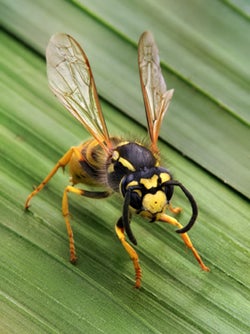The German Yellowjacket, Vespula germanica
The Situation: In southern California, the most widespread yellowjacket has historically been the native, western yellowjacket, Vespula pensylvanica. The German yellowjacket, V. germanica, became established in the Northeastern U.S. in the 1970s and then the Pacific Northwest in the 1980s where it spread down the coast. It reached southern California in 1991 becoming part of California's fauna. There are other Vespula species as well but they are not nearly as common in urban southern California, and they are not considered to be pests.
Damage: The strain of German yellowjacket that has made its way to California has a proclivity to nest in attics or in the walls of buildings. This proximity to people makes this species of yellowjackets more of a public health threat. Solitary foundress queens overwinter in protected places and start new colonies in a structural cavity in the spring. The queen tends her first brood of workers and then becomes nestbound as the colony rapidly increases in size. The nest is constructed of a papier-mâché like substance that surrounds tiers of developing wasps. By July or August there may be more than 4,000 wasps in the nest, which may be more than 2 feet in diameter. A cadre of guard wasps attack if the nest is disturbed. A scent emitted by the guards incites nestmates to attack, often resulting in multiple stings to victims. This pest may pose a significant conservation threat to native animals in California, a problem that has been observed overseas (e.g., New Zealand) where this wasp is invasive.
Economic Impact: Several incidents of evenomization by German yellowjackets have been reported, but no deaths have yet been attributed to them. Eradication and removal of active nests from structures can be difficult and costly. Nests that are killed must be removed to prevent foul odors and the buildup of flies and other scavenger insects. Although yellowjackets collect insect prey, they also scavenge meat which puts them into contact and conflict with humans. These are the wasps which harass people at outdoor eateries, theme parks, receptions and picnics, congregate at bakeries or candy factories, and they actively seek out spilled sodas at sporting stadiums, etc. Their scavenger behavior puts them into interaction with humans which increases the potential for sting incidents as well as being a nuisance which could curtail or cancel outdoor activities.
Distribution: The German yellowjacket is known to be established in several communities around San Francisco and in Los Angeles, Orange and Riverside counties. It also has been reported that this rapidly spreading pest has been found in almost every county of California. Because it nests in protected places, temperature alone does not limit this species. Like other yellowjackets, German yellowjackets are most numerous and pestiferous during the summer, but a few active nests of this species have been found all year long. German yellowjackets in California prefer to nest in buildings, but subterranean nests have been found also. This dual habitat increases the likelihood of people encountering wasps and being stung. German yellowjackets are most commonly found in lowland areas of southern California, and replaced by the native western yellowjacket (Vespula pensylvanica) near the foothills.
Research: Strategies are being developed at the University of California, Riverside to prevent and control this potentially important insect. A synthetic chemical lure in traps is being used to detect this species and to determine when it is troublesome. Research is being conducted to develop safe and effective area-wide baiting programs for instances where German yellowjackets become established. Baits containing growth regulators or entomopathogens are being investigated. Several pesticides have been tested for palatability to yellowjackets with two (fipronil and imidicloprid) being taken in high quantities. These compounds may be useful for localized eradication efforts. Limited field trials showed that Fipronil mixed with ground chicken baits eliminated German yellowjacket populations within hours in small areas. Subsequent monitoring in the following weeks showed no resurgence of German yellowjacket populations in treated areas indicating that a very short experimental exposure of fipronil was sufficient to destroy the colony completely.
Center for Invasive Species Research, University of California Riverside
Text provided by: Donald A. Reierson, Michael Rust , and updated by Mark S. Hoddle
Photos courtesy of Richard Bartz
Hand photo provided by Flickr member justthismoment
Donald A. Reierson, Urban Entomologist
donald.reierson@ucr.edu
Michael Rust, Professor of Entomology
michael.rust@ucr.edu
Mark Hoddle, Extension Specialist and Director of Center for Invasive Species Research
mark.hoddle@ucr.edu
Personal Website






